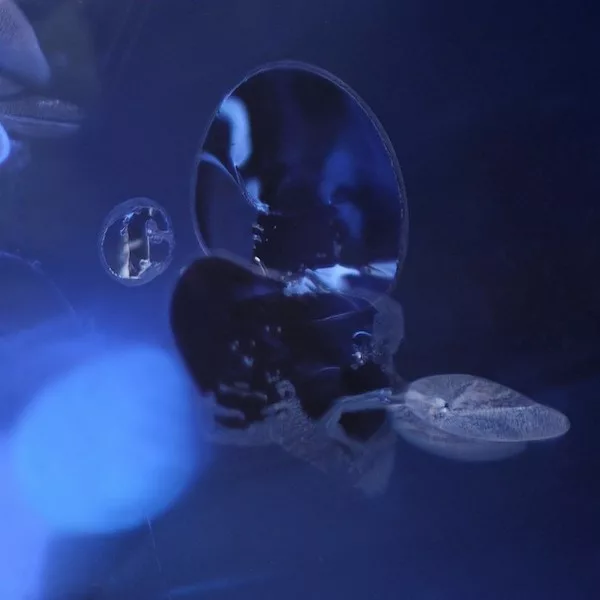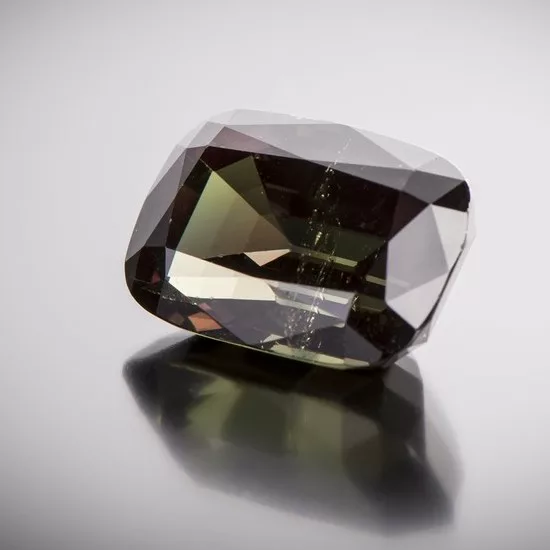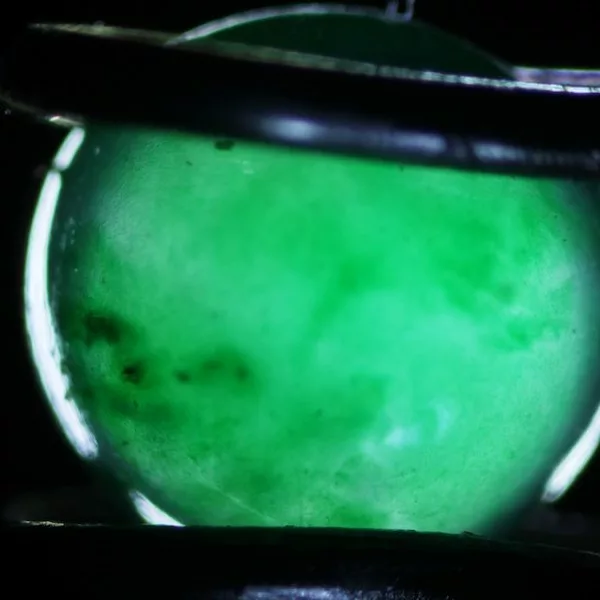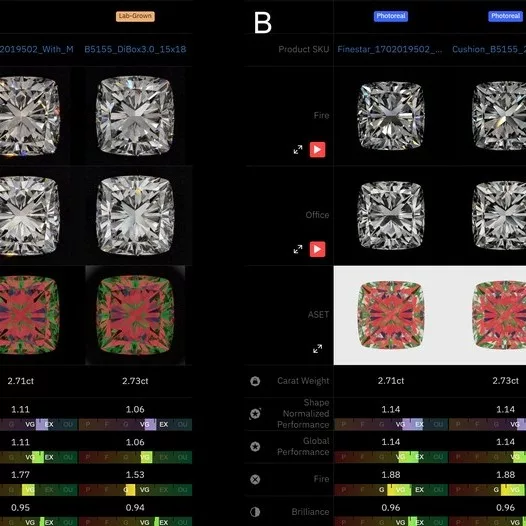Phase transformations as important markers for heat treatment detection in corundum and other gemstones
Keywords: Heat treatment, diaspore, goethite, dehydration, Raman spectroscopy
Introduction
Detection of heat treatment of ruby and sapphire and other colour varieties of corundum is a major issue for the trade and laboratories alike. Heat treatment of corundum is commonly applied in a large temperature range from about 700 to 1800 °C in both, oxidizing and reducing conditions.
Traditionally, the detection of corundum heat treatment is based mainly on meticulous microscopic observation. As a consequence of the heating process, internal features (e.g. fluid and solid inclusions, zoning features) may be affected and altered (Gübelin & Koivula 2006) and by this provide a straightforward evidence of heat treatment. In general, characteristic heating features (e.g. discoid tension cracks around inclusions, see Figure 1) become more prominently visible with increasing temperature (and heating duration). Far more challenging is the microscopic detection of so-called “low-temperature” heated corundum. In these stones which are heated at about 700 °C to 1100 °C only very minute or even no alterations of inclusions may be observed under the microscope (Hughes & Vertriest 2022). Another classic approach is to check for “chalky” fluorescence reactions under shortwave ultraviolet light. However, such reactions can generally only be expected at higher heating temperatures well beyond 1100 °C.
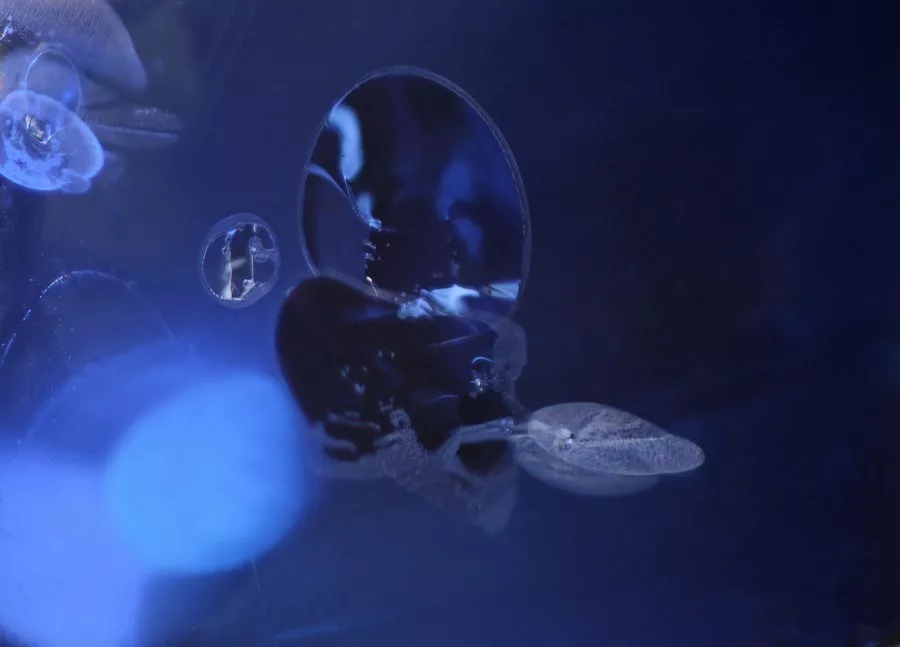
Heat treatment detection is also very much relying on FTIR and Raman spectroscopy. In FTIR, the focus is very much on the presence and intensity of OH- related absorption peaks. Namely the 3309, 3232 and 3185 cm-1 series in metamorphic corundum is considered a strong indication for artificial heat treatment (Smith 1995; Beran & Rossman 2006; Saeseaw et al. 2020; Pardieu et al. 2015; Krzemnicki 2019). The presence or absence of a Mg-O related band at 3160 cm-1 is another important criterion, as this band is reduced or completely disappears during heating (Smith & van der Bogert 2006). Another approach is to determine the peak width (FWHM) of the main Raman peak of zircon inclusions. This approach has been explored more recently (Wang et al. 2006; Krzemnicki et al. 2021; Karampelas et al. 2021), notably in pink sapphires from Ilakaka (Madagascar) as a way to detect heat treatment. However, this criterion remains to some extent difficult and less conclusive, as the FWHM ranges of unheated and heated corundum show considerable overlap (Krzemnicki et al. 2021).
New research experiments on pink sapphires and rubies
This study presents results of heating experiments on pink sapphires (Ilakaka, Madagascar) and rubies (Montepuez, Mozambique) recently carried out at SSEF. These experiments revealed that mineralogical phase transformations occurring in-situ in inclusions within corundum may be very promising markers for the detection of heating – or better for evidence of an absence of heat treatment in a corundum sample. With controlled heating experiments (T, t, oxidizing conditions), two dehydration phase transformations were studied over the past few months.

Both phase transformation systems have been studied extensively in the past decades. Both hydrates, diaspore and goethite are known to be thermally stable only up to about 350-500 °C and to transform to their respective Al- and Fe-oxide phases when further heated (Lima-de-Faria 1963; Ervin 1952; Frost et al. 1999; Gialanella et al. 2010). The dehydration of inclusions of goethite to hematite during the heating of corundum was already described by Koivula (2013) and Sripoonjan et al. (2016).
In our initial (unheated) samples, diaspore and goethite were common epigenetic inclusions. Diaspore was present as a tiny colourless acicular solid phase in fluid inclusions (e.g. negative crystals), giving it a whitish granular aspect. Goethite, introduced at a late stage through meteoric waters in and on the surface of corundum (pebbles) was present as orange-beige staining in fissures and hollow tubes. Selected inclusions in the studied corundum samples together with goethite and diaspore reference samples were analysed by Raman spectroscopy before heating and after each consecutive step of the heating process (300, 400, 600, 800, 1000 °C, one hour peak temperature per heating step). Our Raman spectroscopic analyses clearly show that both phase transformations mentioned above can be well monitored by Raman spectroscopy even if these phases are present only as tiny inclusions in corundum. Both, diaspore and goethite dehydrated inevitably to their oxides (corundum and hematite) at 350-500° C, thus way below the temperatures at which corundum commonly is heat treated.
In summary, the presence of either diaspore or goethite inclusions in corundum can be considered a very strong evidence, that a corundum sample has not been heat treated. It is important to know, however, that the absence of diaspore or the presence of hematite is not necessarily a proof of heating, specifically as hematite precipitations may also occur naturally in corundum. In the past few months, we have applied these phase transformation markers successfully on numerous client stones (Figure 2). By adopting this approach, we were able to conclude a treatment status even in cases where no other feature (microscopically or spectroscopically) was sufficiently conclusive.
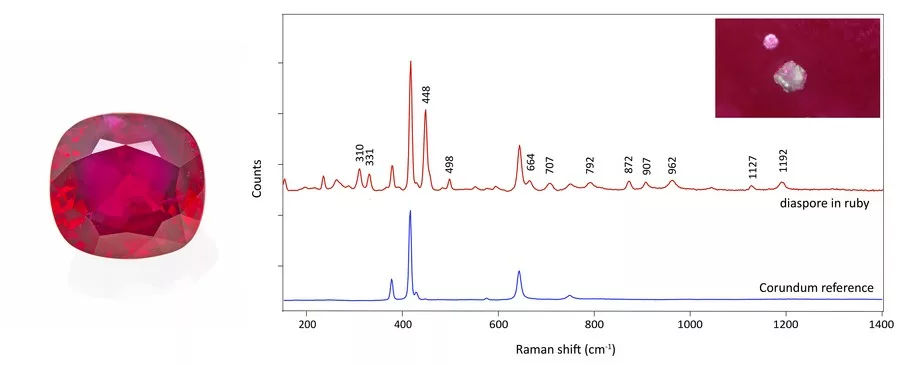
References:
- Beran A., Rossman G.R., 2006. OH in naturally occurring corundum. Eur. J. Mineral. 2006, 18, pp. 441-447
- Ervin, G., 1952. Structural interpretation of the diaspore– corundum and boehmite-Al2 O3 transitions. Acta Crystallogr., 5, 103-108
- Frost R.L., Kloprogge J.T., Russell S.C., and Szetu J., 1999. Dehydroxylation and the vibrational spectroscopy of aluminum (oxo)hydroxides using infrared emission spectroscopy. Part III: diaspore. Applied Spectroscopy, 53 (7), 829-835
- Gialanella S., Girardi F., Ischia G., Lonardelli I., Mattarelli M., Montagna M., 2010. On the goethite to hematite phase transformation. Journal Therm. Anal. Calorim., 102, 867-873
- Gübelin E.J., Koivula J.I., 2006. Photoatlas of Inclusions in Gemstones, Volume 3. Opinio, Basel, 750 pp.
- Hughes E.B., Vertriest W., 2022. A canary in the ruby mine: Low-temperature heat treatment enhancement of Burmese ruby. Gems & Gemology, 58 (4), 400-423 http://dx.doi.org/10.5741/GEMS.58.4.400
- Karampelas S., Hennebois U., Mevellec J.-Y., Pardieu V., Delaunay A., and Fritsch E., 2021. Identification of heated pink sapphires from Ilakaka (Madagascar). The 7th International Gem & Jewellery Conference (GIT), Chanthaburi, Thailand, Abstract Volume, p. 212
- Koivula J.I., 2013. Useful visual clue indicating corundum heat treatment. Gems & Gemology, 49 (3), 160-161. http://dx.doi.org/10.5741/GEMS.49.3.160
- Krzemnicki M.S., 2019. Detection of low-temperature heated rubies from Mozambique. SSEF Facette, 25, p. 9
- Krzemnicki M.S., Lefèvre P., Zhou W., Wang H.A.O., 2021. Zircon inclusions in unheated pink sapphires from Ilakaka, Madagascar: A Raman spectroscopic study. IGC 2021 Proceedings, 21-23
- Lima-de-Faria J., 1963. Dehydration of goethite and diaspore. Zeits. Kristallogr., 119, 176-203
- Pardieu V., Saeseaw S., Detroyat S., Raynaud V., Sangsawong S., Bhusrisom T., Engniwat S., Muyal J., 2015. “Low temperature” heat treatment of Mozambique ruby. GIA Research News, https://www.gia.edu/doc/Moz_Ruby_ LowHT_US.pdf
- Saeseaw S., Khowpong ., and Vertriest W., 2020. Lowtemperature heat treatment of pink sapphires from Ilakaka, Madagascar. Gems & Gemology, 56 (4), 448-457. http:// dx.doi.org/10.5741/GEMS.56.4.448
- Smith, C.P., 1995. A contribution to understanding the infrared spectra of rubies from Mong Hsu, Myanmar. J. Gemmology, 24, 321-335
- Smith, C.P., van der Bogert, C., 2006. Infrared Spectra of Gem Corundum, Proceedings of the GIA Gemological Research Conference, Gems & Gemology, 42(3), 92-93
- Sripoonjan T., Wanthanachaisaeng B., Leelawatanasuk T., 2016. Phase transformation of epigenetic iron staining: Indication of low-temperature heat treatment in Mozambique ruby. Journal of Gemmology, 35 (2), 156-161
- Wang W., Scarratt K., Emmett J.L., Breeding C.M., Douthit T.R., 2006. The effects of heat treatment on zircon inclusions in Madagascar sapphires. Gems & Gemology, 42 (2), 134- 150 http://dx.doi.org/10.5741/GEMS.42.2.134

